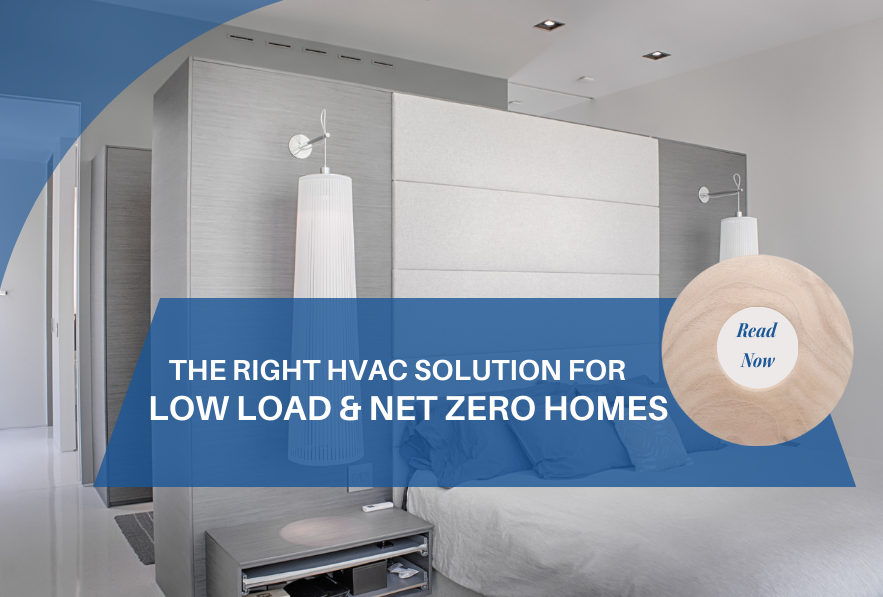
by Unico Marketing Team | Jun 27, 2024 | Cooling, Custom Homes, Design Flexibility, Energy Effeciency, heating, Limited Space
The Right HVAC Solution for Low-Load and Net Zero Homes
According to the U.S. Department of Energy, residential homes are responsible for 21% of the energy used in the country each year. More and more people want to reduce the amount of energy their homes use each year to save costs and to help the environment. These are two core reasons that have contributed to the rise in demand for low-load and net zero homes.
The HVAC system is a crucial piece in the design and build of a low-load or net zero home as it determines how energy efficient a residential home can be. Let’s look at the best HVAC solution for low- load and net zero homes.
Airtight Homes Need a Reliable HVAC System
One of the ways low-load and net zero homes reach high levels of energy efficiency is by having an airtight building space. The structure of the house is specifically designed to reduce the amount of conditioned air that leaks out. This type of design also helps the living space be more comfortable due to less air escaping, allowing for even temperatures.
The HVAC system that’s chosen for low-load and net zero homes is essential. Even when the building has an airtight envelope, leaking ducts throw the system off balance. Traditional metal ductwork is known to have higher levels of thermal loss compared to small-duct, high-velocity (SDHV) systems. That temperature loss forces the HVAC system to work harder, spending more energy to make up for the deficit.
With The Unico System, this is not an issue. The ductwork is one-third the size of traditional ducts and achieves one-third less thermal loss. The supply tubing is wrapped with an outer vapor barrier and insulation that’s designed to keep nearly all the thermal energy inside the ducts. Through third-party testing1, it’s documented that traditional HVAC systems lose up to 25% of the air pushed through the ducts – while Unico loses less than 5%.

The Unico System Can Be Paired with Chiltrix for Added Comfort and Efficiency
Chiltrix by Unico is the leader in air-to-water heat pumps. It’s a great energy-efficient addition to HVAC systems in net zero and low-load homes. The Chiltrix unit pulls in heat from the outdoor air and transfers it to water. Its design allows Chiltrix to be compatible with a variety of popular systems for net zero and low-load homes, like underfloor heating or radiant cooling.
Every Chiltrix unit is a load and capacity-aware heat pump. Plus, there’s a variable-speed inverter compressor and pump to help ensure the system doesn’t use more energy than it needs. It’s one of the best energy-efficient solutions for all-electric homes and is AHRI-certified, just like The Unico System.
Chiltrix by Unico offers all these benefits while ensuring there’s no refrigerant inside the home thanks to its monoblock design. All its critical components, like the compressor, condenser and evaporator, are housed in the outdoor unit. Through insulated water line connections, Chiltrix works with The Unico System to offer homes optimal comfort with high efficiency.
Small Duct, High-Velocity HVAC Systems Fit in Any Home Design
Net zero and low-load homes are built with the targeted intention of reducing energy usage. Part of this process involves putting in heavily insulated walls to reduce thermal loss, reducing the amount of space for traditional metal ducts, insulation and other design elements. This problem is one of the reasons why single-zoned duct systems became popular in net zero homes.
The Unico System is perfect for net zero and low-load homes because it fits where other HVAC systems simply cannot. The small, flexible ducts can be easily woven through the floor or walls–there’s no need to adjust the design of the home to accommodate it. Also, The Unico System is less disruptive than other options–not only keeping the home more comfortable with less energy, but it also saves time during the construction process.
See How The Unico System and Chiltrix Fit Into Your Home Design
If you are a manufacturer or architect, Contact our Design Services Team today and we will look at your modular home plans and develop a system configuration that works. You’ll even be able to install part of the system at the factory for increased efficiency.
If you are a homeowner, Find a Unico Rep to start the process of developing a system configuration that works best for your modular home plans.
1U.S. Department of Energy – Better Duct Systems for Home Heating and Cooling. https://www.nrel.gov/docs/fy05osti/30506.pdf
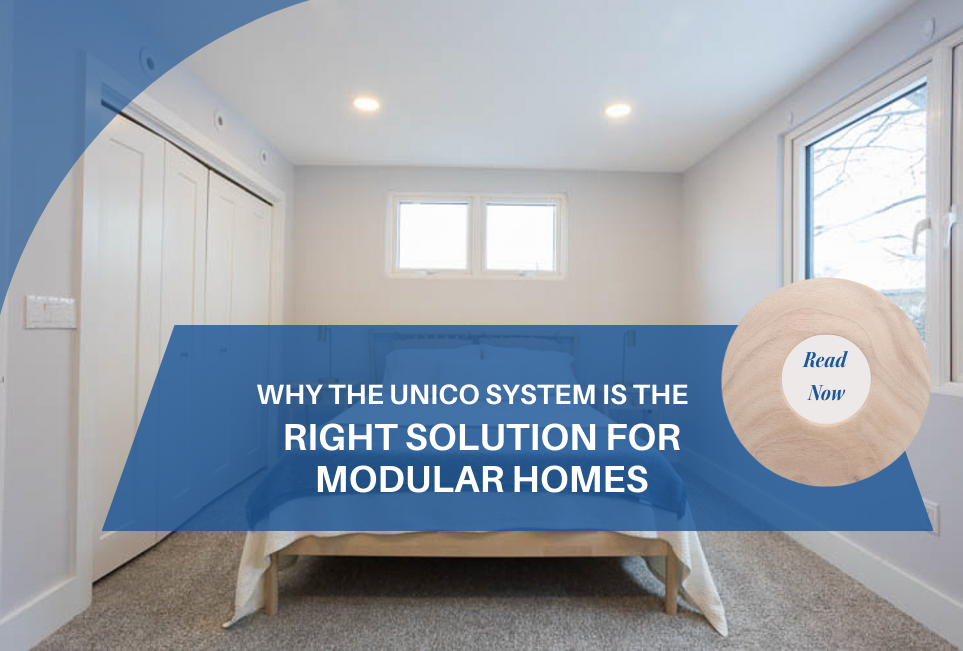
by Unico Marketing Team | Jun 13, 2024 | Cooling, Custom Homes, Design Flexibility, Design Services, Energy Effeciency, heating, Quiet, Uncategorized
Why The Unico System is the Right HVAC Option for Modular Homes
Did you know that the modular home market is expected to grow at an average of 6 percent each year until 2028? As this market expands, more home building companies are looking for ways to streamline their manufacturing. The process of finding the right HVAC system for modular homes is often a challenge. Traditional systems often feature bulky ductwork that may not seamlessly integrate in your design plans.
The Unico System Offers Unmatched Design Flexibility
When a modular home is being built, there are some HVAC systems that slow down the process and create roadblocks. With a traditional HVAC unit, extra time might need to be spent adjusting the design to accommodate the size of the system’s components. For example, a wall might need to be brought in a foot or two so the ductwork can be installed. The Unico System doesn’t require you to build around bulky HVAC components.
The Unico System is small enough to fit in between the floor and roof system (or modules) during the construction process. With most of the ductwork running through the interstitial space, all you’ll see in the rooms are the round outlets. Those outlets can also be customized to match almost any décor. With The Unico System as the HVAC solution for your modular home, you get a less invasive solution that provides optimal comfort.

Installation and Training at the Factory
One of the greatest benefits for modular manufacturers and builders is that both installation and training can be done on-site at the factory. In most cases, a member of the Unico team will then meet you at the job site to oversee the connections between the modules. This ensures that the modules are properly fitted as well as allowing for any adjustments, should they be needed. Therefore, minimizing any potential issues that may arise during the installation process.
Get Energy Efficiency Without Sacrificing Comfort
More and more modular homebuyers want an energy-efficient residence which is the reason why modular home builders are creating passive and net zero designs. If you’re looking for an energy-efficient HVAC system, Unico is the solution. With traditional HVAC units, heat often leaks through the walls of the ducts. While there are building practices that address this, there’s less flexibility with modular homes since a uniform design needs to be followed, which isn’t ideal for traditional HVAC systems.
- Heat can leak through the walls of the duct (thermal loss) and air can leak through its seams (duct leakage). In both cases, the Unico System is far superior to a conventional system. Insulation and size determine the thermal loss. Workmanship and design determine the duct leakage.
- The Unico System ductwork has 1/3 the surface area of conventional ducting so before it is even installed the Unico System ductwork has 1/3 less thermal loss. The supply tubing is also wrapped with insulation and an outer vapor barrier, which keeps nearly all of the thermal energy within the duct.
- In the case of duct leakage, the Unico SDHV system is engineered for simplicity and air tightness. It has been documented through third-party testing that traditional systems can lose up to 25% of the air that the unit puts out through leaky ductwork. The Unico System loses less than 5%. This means that with the Unico System you’re getting what you pay for.
The Unico System doesn’t have this issue since its ductwork takes up only a third of the surface area and only allows a third of the thermal loss of traditional HVAC systems. Every piece of supply tubing is wrapped in insulation and an outer vapor barrier to help keep almost all the thermal energy inside the duct. Through third-party testing, it was found that traditional HVAC systems can lose up to 25% of the air being pushed throughout a home, while The Unico System loses less than 5%.
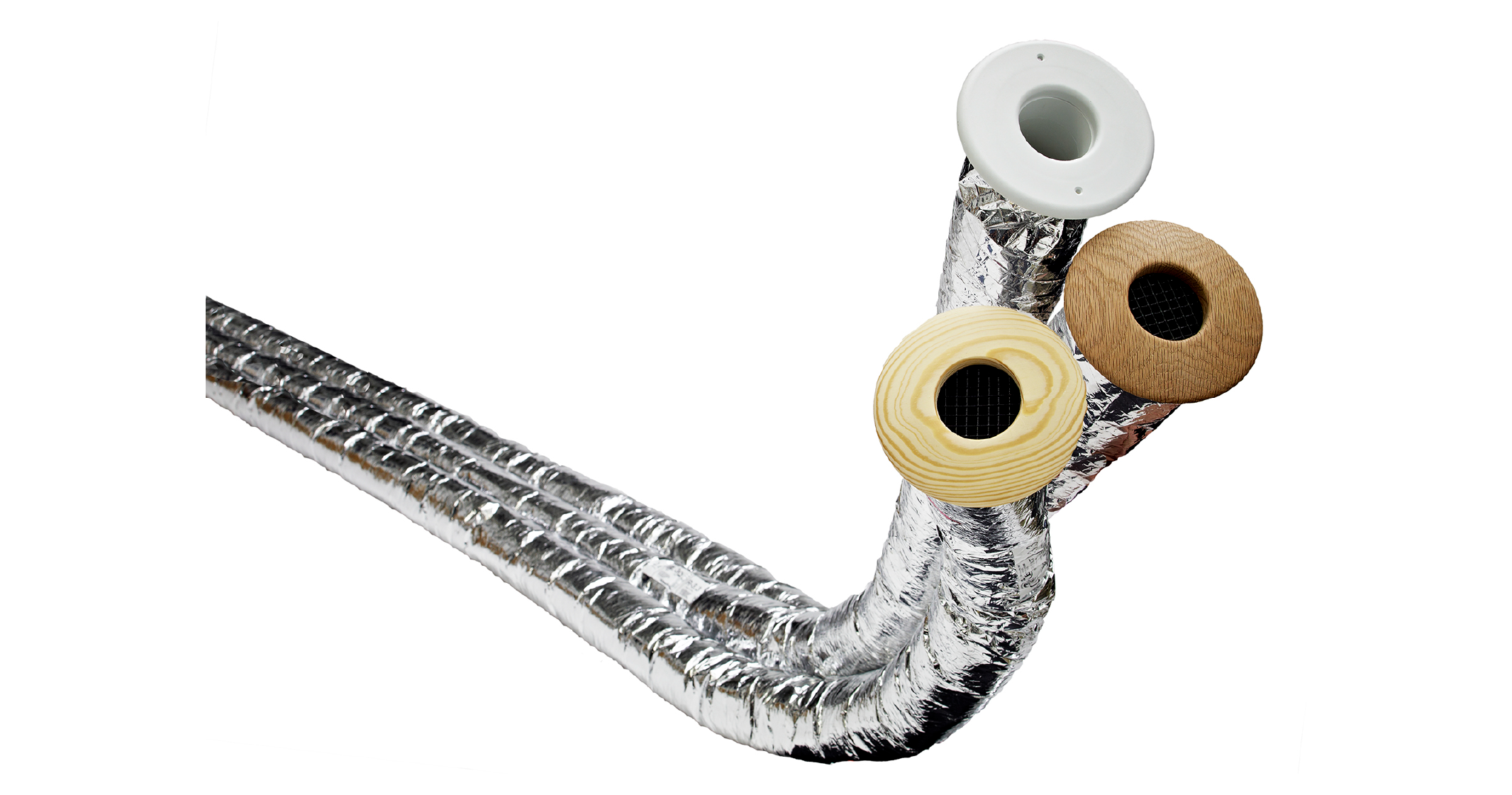
With insulation supply tubing, The Unico System creates a gentle suction that draws the air in the room into its airflow. The result is a temperature differential that’s no more than 2% from the thermostat setting across the entire modular home.
Give Your Modular Home Manufacturing More Flexibility
Instead of having to compromise your modular home design to accommodate an HVAC system, choose an option that can fit into any space. No matter what type of modular home design you’re manufacturing, The Unico System is the right HVAC solution. This small yet powerful HVAC system won’t compromise your design and can deliver comfort throughout the home.
Because The Unico System’s supply tubing is lined with a nylon inner core that absorbs the sound and vibration of air being pushed through the system, The Unico System runs whisper-quiet.
The Unico System Design Process for Modular Homes
If you are a manufacturer or architect, Contact our Design Services Team today and we will look at your modular home plans and develop a system configuration that works. You’ll even be able to install part of the system at the factory for increased efficiency.
If you are a homeowner, Find a Unico Rep to start the process of developing a system configuration that works best for your modular home plans.
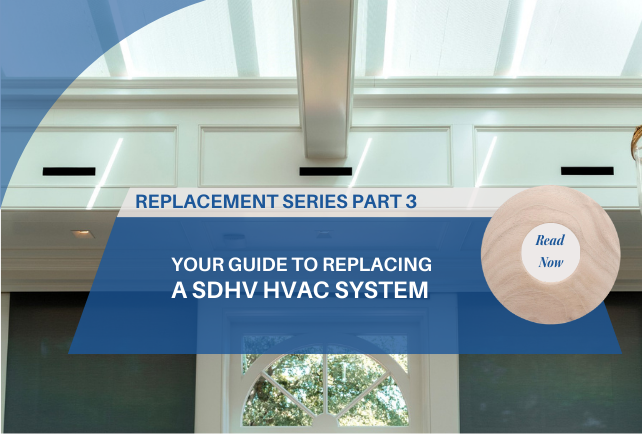
by Unico Marketing Team | May 16, 2024 | Cooling, Custom Homes, heating, Maintenance, Older Homes
Your Guide to Replacing a Small-Duct, High-Velocity HVAC System
In this final installment of our HVAC replacement series, we’re going to focus on small-duct, high-velocity (SDHV) systems. The Unico System is the leader in this HVAC technology. However, the SDHV system is a newer technology in the HVAC industry and knowing when a unit needs to be replaced isn’t always easy.
The Unico System is here to help. Let’s get into more detail about how to tell when it’s time to swap out an SDHV system and what options you should consider replacing it with.
When is it Time to Replace an SDHV HVAC System?
SDHV systems are known to have smaller outlets that are less noisy than traditional HVAC systems. With many traditional units, hearing the fan or motor straining to operate is a textbook sign that the system needs to be replaced. With SDHV systems, the replacement signs are often more subtle. You’ll want to be on the lookout for:
- A Decline in Energy Efficiency: Small-duct, high-velocity HVAC systems have tight joints and insulated tubing for increased energy efficiency. If you notice that your home’s heating and cooling bill has increased, it could be a sign that the HVAC unit needs to be replaced. SDHV systems at the end of their life cycle are more likely to lose air velocity, making the whole unit work harder to keep rooms at an even temperature.
- The Age of Your HVAC System: Even though SDHV units are efficient and provide optimal comfort, no system can last forever. Core elements of these systems, like the heat pump, blower coil and air handler, all have shelf lives. Many of the key components have estimated life spans provided by the manufacturer. If your HVAC system is more than 10 years old, it’s time to pay close attention to how it’s operating.
- Longer Heating and Cooling Cycles: SDHV units don’t just dump air into rooms like traditional HVAC systems. The SDHV system has fairly uniform heating and cooling cycles. If you notice that these cycles have gotten longer, it’s a sign that the system isn’t running as efficiently—that the unit is struggling to keep up with the temperature set by the thermostat. If this issue persists, call a professional to inspect the system and see if you might need to replace it.
Why The Unico System is the Best Replacement Option for Small-Duct, High-Velocity HVAC Systems
Once you have the comfort and efficiency that a small-duct, high-velocity HVAC system provides, it’s hard to go back. Luckily, you won’t have that problem when choosing The Unico System as your HVAC solution. To create a draft-free environment with even temperatures, The Unico System takes advantage of a process called aspiration. The small, high-velocity ducts placed throughout each room create a gentle suction that draws air into their streams. You can expect a temperature differential no more than 2 degrees from what the thermostat is set to.
Unlike some other small-duct, high-velocity HVAC systems, Unico has a wide selection of outlet choices designed to match any décor. Unico outlets can also be painted or stained to perfectly match the interior design. Plus, the small outlets are less invasive and can be installed in ceilings, sidewalls and floors so that they’re hardly even noticeable.
Get Free Designs Services with The Unico System
When you’re replacing an existing SDHV system, Unico is here to do the hard part. When you submit plans to our Design Services team, they’ll figure out the best system configuration for your home and provide an estimated materials list. When it comes to indoor comfort, there’s no better HVAC option than The Unico System. Contact our Design Services team today to get started.
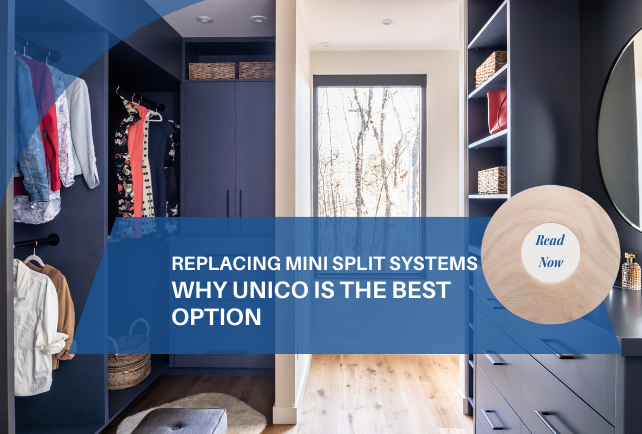
by Unico Marketing Team | May 2, 2024 | Indoor Air Quality, Older Homes, Quiet, Uncategorized
While there are a variety of HVAC systems, mini splits gained popularity for being a flexible system that can fit in small spaces. Mini split systems are also great at conditioning individual rooms and are known to be energy efficient. However, there are better HVAC options to replace or upgrade mini split systems with.
In part two of our HVAC replacement series, we’re going to identify the signs that it is time to replace a mini split system and some of the best upgrade options to consider.
When is it Time to Replace a Mini Split HVAC System?
Mini split systems have units that attach to a wall or window to condition the room. While it allows precise heating and cooling, mini splits require a unit present in each space that needs to be temperature controlled. Each unit requires routine maintenance, which can add up quickly. In fact, one of the key signs that a mini split system needs to be replaced is increasingly frequent breakdowns and repairs. Since mini split units can be costly to fix, it’s important to weigh those repairs against the cost of upgrading to a better HVAC system.
Other signs to look for include:
• Having an Older System: The lifespan of mini split systems averages 10 to 15 years. Any unit past this window will likely need to be replaced.
• Rising Energy Costs: If your mini split unit isn’t conditioning your home air efficiently, your monthly energy bills can increase. It’s a sign that the system needs to run more often to keep up with the temperature set by the thermostat.
• Units Making Noise: Usually, mini split systems are quiet while they’re conditioning rooms. If you hear any part of the system making noise, it’s a sign that it could be damaged.
Why You Should Choose The Unico System to Replace a Mini Split System
One of the biggest disadvantages of a mini split system is how the appearance of indoor units clash with the interior. Even when these units are designed to have a low visual impact, they still stick out. With The Unico System, you won’t have to worry about this issue. The air outlet vents are designed to match the décor of almost any home. The vents can be painted or stained to match a variety of interior design styles from modern homes to log cabins. Since The Unico System ducts are small, they can be installed into the floor, ceiling, and even sidewalls.
Get Better Indoor Air Quality for Your Home
Most mini split HVAC systems feature a reusable filter that operates within each individual unit. Since these filters need to be small to fit inside the system, they provide less air filtration when compared to The Unico System. They also need to be cleaned or replaced more often, adding to more ongoing HVAC maintenance.
Air filters for HVAC systems often have a MERV rating. A higher rating means there’s more air restriction to help the filter and capture smaller particles. Mini split systems are often not designed or compatible with high MERV-rated filters. Thanks to its small-duct, high-velocity design, The Unico System can easily handle the high-pressure drops caused by air restrictions, which is why it can be outfitted with MERV 13 filters, offering exceptional protection against airborne particulates.
Since the ducts are smaller with The Unico System, it’s easier to incorporate a UV light cabinet into the system to help disinfect the air that circulates through your home. This offers peace of mind by reducing airborne bacteria and improves your overall indoor air quality.
Optimal Comfort While Being Whisper Quiet
Since there are individual units in every room, mini split systems have zone control. However, they cannot reach the same level of temperature control as The Unico System. Each mini split unit dumps air into a room and often causes uneven temperatures since the system has less power dedicated to circulating air. You do not run into this issue with The Unico System. Through an air principle called aspiration, the ducts create a suction that pulls air around the room into its stream of air. This creates a temperature differential of no more than two to three degrees from what your thermostat is set to.
Every HVAC system, including mini split units, makes noise while running. Even though mini split units are quieter than a traditional system, most of them are not insulated like The Unico System. The Unico air supply tubing uses a nylon inner core that is designed to absorb noise caused by air moving through the system. Even the air handler is designed to isolate noise and vibration to help ensure the entire system stays quiet. It works so effectively that you won’t even notice The Unico System running.
Upgrade Your Home HVAC with The Unico System
By replacing a mini split HVAC system, you could make your home more comfortable, energy efficient, and improve indoor air quality. Find a Unico Preferred Contractor near you to get the process started.
Photo Credit: Mike Casey, This Old House

by Unico Marketing Team | Apr 11, 2024 | Cooling, heating, Older Homes
Did you know that according to the U.S. Department of Energy, roughly 3 million HVAC systems are replaced each year? With so many of these projects happening, it’s important for homeowners, contractors and builders to have the information needed to make the best replacement decision. In this first post of our three-part blog series on HVAC system replacement, we’re taking a closer look at traditional systems.
Join us to learn about when it’s time to replace a traditional HVAC system, how their performance compares to other options, and more!
An Overview of Traditional HVAC Systems
With a traditional HVAC system, one of the biggest advantages they offer is being budget friendly. Homes due for a heating and cooling makeover will often go with a traditional HVAC unit because they know what to expect. Plus, if a home has existing ductwork built into the infrastructure, these systems can be installed with limited hassle and downtime.
Unfortunately, traditional HVAC systems have a few drawbacks as well. For starters, they’re not the most energy-efficient option for homes. These units don’t condition the entire room evenly since air is dumped into the space usually from one vent. This leads to uneven temperatures, which causes a traditional HVAC system to run longer as it works to catch up to the thermostat. It’s also important to note that these systems take up a lot of space, which can make adding on or upgrading them more challenging.
When Should You Replace a Traditional HVAC System?
One of the best ways to figure out if your HVAC system needs to be replaced is looking at how much is being spent per year on repairs and maintenance. If you’re spending $1,000 to $1,500 on upkeep in a year, it’s time to consider replacing the system. Other signs that indicate it’s time to swap out your system include:
• Seeing your monthly energy bills rise
• Rooms in your house have uneven temperatures
• The current HVAC system is always running
• Your HVAC system is more than 10 years old
At the start of the replacement process, you’ll want to take a close look at your home to see what other improvements need to be made to support a new HVAC system. For example, if your home still has the original windows, you may want to upgrade them to help reduce temperature loss.
What Goes Into Replacing a Traditional HVAC System?
When it’s time to replace a traditional HVAC system, there are a few essential steps you’ll want to take. First, knowing what type of new system you would like to replace it with is helpful. This will give you insight into whether existing ductwork or other aspects of a home’s infrastructure need to be upgraded or repaired. Older homes might need new electrical hookups installed to accommodate modern HVAC equipment, for example.
It’s also common for the return and/or intake ducts to be resized to be compatible with modern equipment. With older homes, there’s a strong chance that the home itself was designed for heat only when it was first built. With a new system, consider whether there are any upgrades that need to be put in place to allow for better cooling. In fact, some HVAC brands can help with this through system design services. By reviewing your home’s plans, Unico offers a free service that includes a system design and estimated materials list.
The Unico System is the Best Choice for Replacing a Traditional HVAC System
Did you know that The Unico System fits in any space? No matter what the layout of your home, The Unico System can be installed without re-working the interior design and structure. In fact, it takes up roughly one-third the space of a traditional HVAC unit. Instead of dumping air into a room and creating uneven temperatures, The Unico System uses aspiration to create a more comfortable living environment. The small-duct, high-velocity outlets create a gentle suction that pulls the room air into its own air stream.
When you choose The Unico System to replace a traditional HVAC unit, you don’t have to worry about it clashing with existing décor. Outlets can be made specifically to match the interior design of your home. They can also be installed in ceilings, floors or sidewalls, making the outlets less invasive and barely noticeable.
Find a Unico Preferred Contractor to Replace Your Traditional HVAC Unit
If you need to replace a traditional HVAC unit, The Unico System is the perfect choice. You can put a Unico unit in almost any out-of-the-way space due to its modular and customizable design. Make the HVAC replacement process a breeze by finding a Unico Preferred Contractor in your area. Click here to get one step closer to having draft-free and even temperature comfort in every room.
Featured image TOH, Mike Casey








